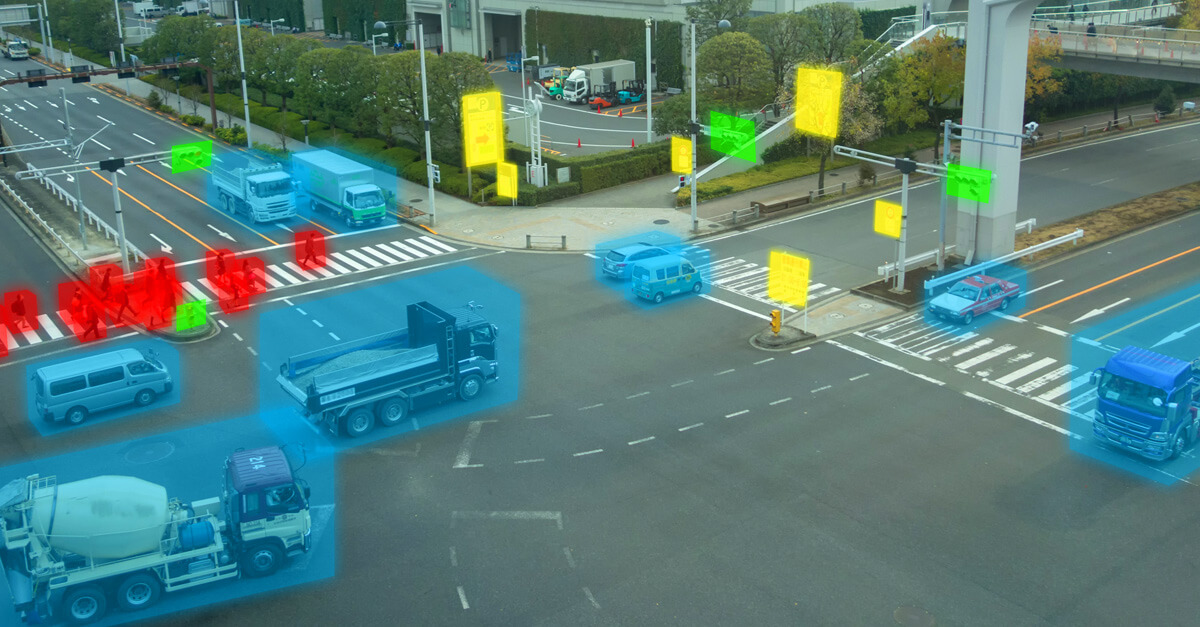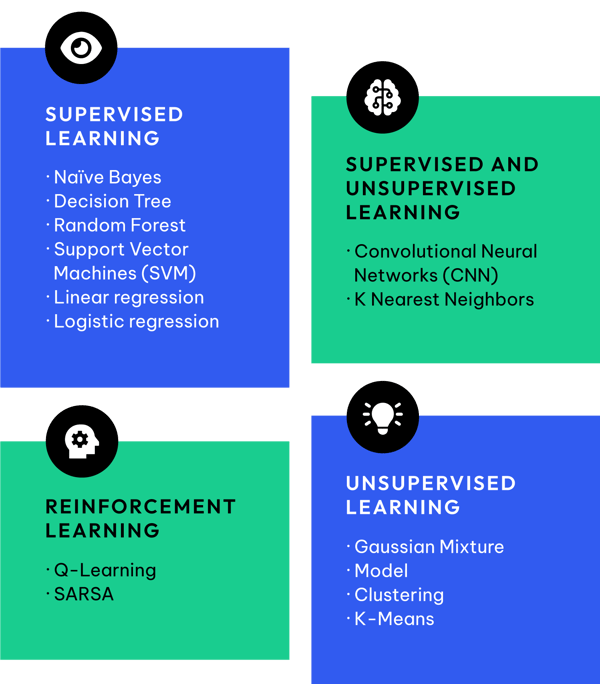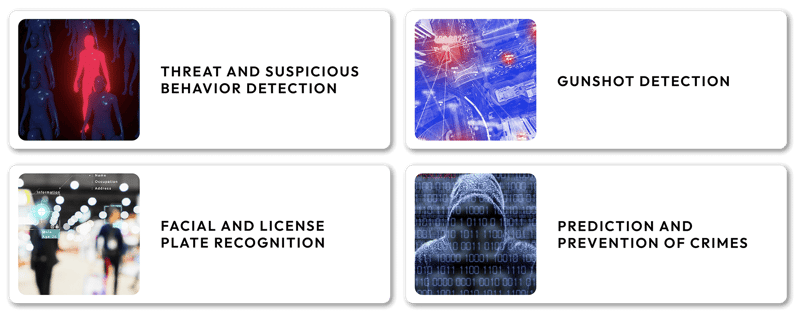
Within today's ever-evolving technological landscape, artificial intelligence (AI) stands out as one of the most transformative forces. Several industries are altering their operations, structure, and, most importantly, their relationship with technology.
In this article, we will delve into the intricate workings of AI algorithms, their various types, and their impact on several sectors, highlighting specifically what has been achieved in the realm of public safety.
Table of contents
- What are artificial intelligence (AI) algorithms?
- Current State of the AI algorithms
- How do artificial intelligence (AI) algorithms work?
- Main types of artificial intelligence (AI) algorithms
- Uses of artificial intelligence (AI) algorithms
- The future of artificial intelligence (AI) in public safety
What are artificial intelligence (AI) algorithms?
In basic terms, an algorithm is a set of instructions that computers receive and follow to perform specific tasks or solve problems.
To understand the importance of artificial intelligence algorithms, it is important to comprehend that artificial intelligence is the field of computer science concerned with computer decision-making and thinking abilities. One of its aims is to develop computer systems that can execute tasks that usually require human intelligence like translation between languages, visual and speech recognition, and decision-making.
Due to the recent developments in machine learning (a branch of AI that is concerned with using data in a similar way to that in which humans learn so it can improve its precision), artificial intelligence algorithms have become powerful tools that can be used to achieve natural language processing, image recognition, and decision-making. These algorithms allow us to reshape how we approach ordinary tasks, data management, mathematical problems, and even public safety and crime prevention.

The current state of the AI algorithms
AI algorithms are being integrated into various industries due to the recent unprecedented advances in their development. Because of their ability to process extensive amounts of data in real-time and their capability to extract meaningful information faster than a human mind, they have been considered a more proactive approach to various tasks, changing the way the world works.
They have been integrated to different healthcare systems to assist in diagnosis and even to predict disease progression, to finance for fraud detection and credit scoring, to retail and e-commerce, and even to everyday life in the form of digital assistants like Siri or Alexa.
How do artificial intelligence (AI) algorithms work?
One thing is clear: AI algorithms are more complicated than regular algorithms. The characteristic that differentiates them the most is that AI algorithms can take the data they receive as a sort of training, which in turn helps them learn and improve their accuracy.
However, this process is more complex than it might seem because giving a computer the power to learn in a “human way” is not a simple task. The process involves the use of several AI techniques, and it is still in constant change due to technology’s fast advancements.
First of all, AI algorithms use machine learning to learn from the data they receive without being explicitly programmed for it. This allows us to classify them into three categories depending on how they learn: supervised, unsupervised, and reinforcement learning (we will delve more deeply into their definition in the next section).
Deep learning, the method that allows computers to process data in a sort of human fashion, is also one of the factors that makes AI algorithms work and allows them to make predictions based on the data they have received beforehand. Finally, the field of natural language processing (NLP) is the part that is in charge of the communication between machines and human language because it makes it possible for machines to recognize, understand, and then generate something in a textual or spoken form.
The importance of AI algorithms lies in their ability to automate tasks that are typically error-prone and time-consuming if executed by a human being.
Because of their ability to learn and adapt, they are constantly improving their efficiency and precision. Thanks to their current capabilities, AI algorithms are currently crucial for making improvements in public safety. Their predicting capabilities, enhanced decision-making along with their efficiency allow us to prevent accidents or crimes, which helps to improve emergency response times and resource allocation.
MAIN TYPES OF AI ALGORITHMS

4 Main types of artificial intelligence (AI) algorithms
As it was stated in the previous section, the three main categories of AI algorithms are supervised learning, unsupervised learning, and reinforcement learning.
Each of them has different processes for learning and their different functions allow them to be applied in a variety of fields.
1. Supervised Learning Algorithms
This type of algorithm is trained on labeled datasets, which means that it learns to map input data to specific output based on set examples. It is mostly used to make classifications based on patterns learned during training. Here are some of the most popular examples of this type:
Naïve Bayes:
Built on a probability model, this type of algorithm is based on the assumption that “the presence of a particular feature is unrelated to the presence of other features in the same class”. It is mainly used for spam filtering, recommendations, and sentiment analysis. It is called “naïve” because of the assumption of class conditional independence.
Decision Tree:
Its name derives from the similarity in the shape of its structure to a tree. This algorithm contains the training data at the “roots” which split into branches that lead to specific nodes and therefore, to different conclusions. This sort of algorithm is useful for decision-making.
Random Forest:
It is an assortment of different decision trees connected, which improves the accuracy of prediction. They can be used for classification and regression (this concept will be further explained in a different section of this article).
Support Vector Machines (SVM):
Primarily used for classification, this algorithm finds a hyperplane that best separates data into distinct classes. It is predominantly utilized for image and voice recognition for it has also been implemented in the medical field.
Linear regression:
Similar to SVM, the data points are arranged in a linear way to model and analyze the relationship between input variables and a continuous outcome. A real-life example of how linear regression is implemented can be found in the medical field, where doctors use it to identify the correlations between sugar intake and high blood sugar levels.
Logistic regression:
It is utilized for binary classification tasks where the answer is either yes or no (1 or 0). It estimates the probability of an input belonging to one of the two classes. Anexample of its implementation in banking is the fact that it allows us to identify if a transaction is fraudulent based on the amount of the transaction and the credit score of a certain individual.
2. Unsupervised Learning Algorithms
Unsupervised learning algorithms receive data that is not labeled which they use to create models and to determine the relationship between different data points to better understand it. Several unsupervised learning algorithms work by classifying the unlabeled information into pre-defined clusters to have each data point belong to only one cluster, with no intersections. We will now analyze some further examples of clustering algorithms.
K-Means Clustering:
In this model, the “K” stands for the number of clusters into which the data can be sorted. The data is divided into circular-shaped clusters based on similarity, finding the natural patterns within the unlabeled data. It is a helpful tool for customer segmentation and anomaly detection.
Gaussian Mixture Model:
Similar to the previous model, the data gets sorted into pre-determined clusters; however, the Gaussian mixture model can identify complex data distributions because it gives more freedom to the shapes of the clusters by introducing a probabilistic approach that models data points as a mixture of multivariant gaussian distributions. In simple terms, it tells us how probable is that a data point belongs to each cluster.
3. Both supervised and unsupervised algorithms
These types of algorithms can use both labeled and unlabeled data and perform its functions normally. However, their applications do vary depending on the type of data introduced.
K Nearest Neighbors
Based on feature similarity, K nearest neighbors classify a data point based on how its neighbors are classified. The “k” in the name refers to the number of nearest neighbors to include in the majority voting classification process (the data point will get assigned to the class most common among that sample of k neighbors). If using unlabeled data, this algorithm is convenient for anomaly detection. With label data, it can be used for classification.
Convolutional Neural Networks (CNN):
Convolutional Neural Networks specialize in pattern recognition by trying to imitate the way the human brain works. With the aid of a series of filters, they can identify hierarchical features from images, making them vital in video surveillance and facial recognition. They are also essential for image classification, object detection, and image generation.
4. Reinforcement Learning
These algorithms learn through interaction with an environment, receiving “rewards” or “punishments” which allows them to improve their performance. The feedback they receive grants them the opportunity to modify their behavior to get the best results possible. Reinforcement learning comprises an agent, a sequence of states and a set of actions which allow the agent to switch to different states. A certain action performed in a certain state can yield a reward in the form of a numerical score. Some of the most common examples of reinforcement algorithms are:
Q-Learning:
It is a model-free reinforcement learning algorithm that aims to maximize a reward over time, this means that its main objective is to learn the optimal action-selection strategy for an agent in a given environment. It has applications in robotics, game-playing, and autonomous systems.
SARSA:
SARSA (state-action-reward-state-action), in a very similar way to Q-learning, focuses on learning optimal policies for agents. It considers the current state, the action taken, the reward received, and the next state to make decisions. The main difference between Q-Learning and SARSA is that the latter is used when we care about the agent’s performance during the learning process and we want to avoid negative feedback as much as possible (this becomes important if working with, for example, an expensive robot). It is used in applications like robotic control and autonomous navigation.
Uses of artificial intelligence (AI) algorithms
In the vast realm of technology, AI stands as a beacon of innovation, touching virtually every industry with its transformative capabilities. But how exactly is AI being integrated into various sectors, and what benefits does it bring?
In this section, we'll explore the diverse applications of AI algorithms, highlighting their pivotal role in shaping the future of industries ranging from retail to analytics.
1. Retail: AI algorithms have revolutionized the retail industry. From personalized shopping experiences to inventory management, AI plays a pivotal role. For instance, recommendation systems analyze a user's purchase history and browsing behavior to suggest products that they might be interested in. This not only enhances the shopping experience for the customer but also boosts sales for the retailer.
2. Industrial: In the industrial sector, AI algorithms are used for predictive maintenance, optimizing supply chains, and enhancing safety protocols. Machines equipped with sensors can predict when they might break down, allowing for timely maintenance and reducing downtime. Moreover, AI can analyze vast amounts of data to optimize supply chain operations, ensuring timely delivery of products and minimizing costs.
3. Finances: Financial institutions and online businesses use AI algorithms to detect and prevent fraudulent activities. By analyzing transaction patterns, AI can flag unusual behavior, helping to prevent unauthorized transactions and protect consumers.
4. Business Growth: Data analytics powered by AI can provide businesses with insights that were previously unimaginable. From predicting market trends to understanding customer behavior, AI-driven analytics can offer actionable insights that drive business growth.
Four applications of Artificial Intelligence (AI) in law enforcement
Public safety is paramount, and with the advent of AI, our approach to ensuring it has seen revolutionary advancements.
AI's ability to analyze, predict, and act has opened new horizons in safeguarding communities and responding to emergencies.
In this section, we'll delve into four key applications of AI in public safety, showcasing how technology is becoming an indispensable ally in our quest for a safer world.
1. Prediction and Prevention of Crimes: AI algorithms can analyze vast amounts of data from various sources like social media, surveillance cameras, and police reports to predict potential criminal activities. By understanding patterns and trends, law enforcement agencies can take proactive measures to prevent crimes.
2. Gunshot Detection: Advanced AI systems can detect gunshots in real-time, pinpointing their exact location. This allows for a rapid response from law enforcement, potentially saving lives.
3. Facial and License Plate Recognition: AI-powered cameras can recognize faces and license plates, aiding in the identification of criminals or finding missing persons. This technology is also used at border checkpoints and in traffic management.
4. Threat and Suspicious Behavior Detection: Using surveillance footage, AI can detect suspicious behaviors or potential threats in crowded areas, enabling timely interventions. This is especially useful in public events or high-security zones.
The application of artificial intelligence in law enforcement is a testament to the power and potential of technology to enhance everyday life and ensure a safer environment for all.
As technology continues to advance, it is likely that we will see even more innovative applications of AI in this and other fields, proving that AI is more than just a simple tool: it is a transformative force in the modern world.
4 APPLICATIONS OF AI IN LAW ENFORCEMENT

The future of artificial intelligence (AI) in public safety
The future of AI in public safety looks promising. As technology continues to evolve, we can expect even more accurate prediction models, better surveillance systems, and faster emergency responses. The integration of AI with other emerging technologies like the Internet of Things (IoT) will further enhance public safety measures.
In conclusion, AI algorithms are not just about making machines smarter; they are about making our world safer, more efficient, and more responsive to our needs. As we continue to integrate AI into various sectors, we can look forward to a future where technology works hand in hand with humans to create a better tomorrow.
If you want to learn more about AI video surveillance, read our article here. And learn everything about video analytics in our full guide here.